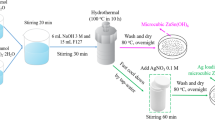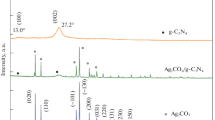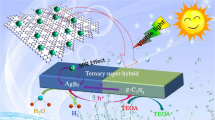Abstract
Plasmonic nanomaterials have wide applications in many fields, such as photocatalysis, solar cell, and new energy generation system. Among them, AgCl–Ag nanomaterials with excellent plasmonic property are getting more and more attention. In this work, AgCl@Ag core–shell nanocubes (AgCl@Ag CS-NCs) with highly uniform morphology and controlled composition have been successfully prepared by the partial reduction of AgCl nanocubes. The morphology, composition, and structure of AgCl@Ag CS-NCs have been investigated systematically. AgCl@Ag CS-NCs with the ratio of AgCl/Ag = 2.7:1 show the optimizational photocatalytic activity for the reduction of representative carcinogenic contaminant (CrVI), which is much higher than that of commercial P25 photocatalyst. The localized surface plasmon resonance and Schottky junction of AgCl@Ag CS-NCs contribute to the high photocatalytic activity for the CrVI photoreduction. After 5 times recyclable catalysis, the high photocatalytic activity of AgCl@Ag CS-NCs can still be maintained well, which demonstrates that AgCl@Ag CS-NCs possess excellent reusability and stability. The high activity and durability make AgCl@Ag CS-NCs to become a promising candidate for the environmental pollution purification under the sunlight irradiation condition.





Similar content being viewed by others
References
Xiang Q, Cheng B, Yu J (2013) Hierarchical porous CdS nanosheet-assembled flowers with enhanced visible-light photocatalytic H2-production performance. Appl Catal B Environ 138–139:299–303
Wang S, Li D, Sun C, Yang S, Guan Y, He H (2014) Synthesis and characterization of g-C3N4/Ag3VO4 composites with significantly enhanced visible-light photocatalytic activity for triphenylmethane dye degradation. Appl Catal B Environ 144:885–892
Schultz DM, Yoon TP (2014) Solar synthesis: prospects in visible light photocatalysis. Science 343:1239176
Meichtry JM, Colbeau-Justin C, Custo G, Litter MI (2014) TiO2-photocatalytic transformation of Cr(VI) in the presence of EDTA: comparison of different commercial photocatalysts and studies by time resolved microwave conductivity. Appl Catal B Environ 144:189–195
Chen Y, Zhang J, Zhang M, Wang X (2013) Molecular and textural engineering of conjugated carbon nitride catalysts for selective oxidation of alcohols with visible light. Chem Sci 4:3244
Wang Q, Chen X, Yu K, Zhang Y, Cong Y (2013) Synergistic photosensitized removal of Cr(VI) and Rhodamine B dye on amorphous TiO2 under visible light irradiation. J Hazard Mater 246–247:135–144
Veerakumar P, Veeramani V, Chen SM, Madhu R, Liu SB (2016) Palladium nanoparticle incorporated porous activated carbon: electrochemical detection of toxic metal ions. ACS Appl Mater Interfaces 8:1319–1326
Koley P, Sakurai M, Aono M (2016) Controlled fabrication of silk protein sericin mediated hierarchical hybrid flowers and their excellent adsorption capability of heavy metal ions of Pb(II), Cd (II) and Hg(II). ACS Appl Mater Interfaces 8:2380–2392
Gusmão R, Sofer Z, Nováček M, Luxa J, Matějková S, Pumera M (2016) Multifunctional electrocatalytic hybrid carbon nanocables with highly active edges on their walls. Nanoscale 8:6700–6711
Lu HJ, Wang JK, Ferguson S, Wang T, Bao Y, Hao HX (2016) Mechanism, synthesis and modification of nano zerovalent iron in water treatment. Nanoscale 8:9962–9975
He XL, Liu YP, Gong KN, Han ZG, Zhai XL (2015) Copper-organic cationic ring with an inserted arsenic-vanadium polyanionic cluster for efficient catalytic Cr-VI reduction using formic acid. Inorg Chem 54:1215–1217
Gong K, Wang W, Yan J, Han Z (2015) Highly reduced molybdophosphate as a noble-metal-free catalyst for the reduction of chromium using formic acid as a reducing agent. J Mater Chem A 3:6019–6027
Bhowmik K, Mukherjee A, Mishra MK, De G (2014) Stable Ni nanoparticle–reduced graphene oxide composites for the reduction of highly toxic aqueous Cr(VI) at room temperature. Langmuir 30:3209–3216
Tu W, Li K, Shu X, Yu WW (2013) Reduction of hexavalent chromium with colloidal and supported palladium nanocatalysts. J Nanopart Res 15:1593
Krishnani KK, Srinives S, Mohapatra B, Boddu VM, Hao J, Meng X, Mulchandani A (2013) Hexavalent chromium removal mechanism using conducting polymers. J Hazard Mater 252:99–106
Tokunaga TK, Wan J, Firestone MK, Hazen TC, Schwartz E, Sutton SR, Newville M (2001) Chromium diffusion and reduction in soil aggregates. Environ Sci Technol 35:3169–3174
Kim C, Zhou Q, Deng B, Thornton EC, Xu H (2001) Chromium (VI) reduction by hydrogen sulfide in aqueous media: stoichiometry and kinetics. Environ Sci Technol 35:2219–2225
Guan X, Chen Y, Fan H (2017) Stepwise deprotonation of magnetite-supported gallic acid modulates oxidation state and adsorption-assisted translocation of hexavalent chromium. ACS Appl Mater Interfaces 9:15525–15532
Wu ZY, Liang HW, Li C, Hu BC, Xu XX, Wang Q, Chen JF, Yu SH (2014) Dyeing bacterial cellulose pellicles for energetic heteroatom doped carbon nanofiber aerogels. Nano Res 7:1861–1872
Rahman MM, Im SH, Lee JJ (2016) Enhanced photoresponse in dye-sensitized solar cells via localized surface plasmon resonance through highly stable nickel nanoparticles. Nanoscale 8:5884–5891
Wen T, Zhang H, Chong Y, Wamer WG, Yin JJ, Wu X (2016) Probing hydroxyl radical generation from H2O2 upon plasmon excitation of gold nanorods using electron spin resonance: molecular oxygen-mediated activation. Nano Res. 9:1663–1673
Wang P, Huang B, Qin X, Zhang X, Dai Y, Wei J, Whangbo MH (2008) Ag@ AgCl: a highly efficient and stable photocatalyst active under visible light. Angew Chem Int Edit 47:7931–7933
Lou Z, Huang B, Qin X, Zhang X, Cheng H, Liu Y, Wang S, Wang J, Dai Y (2012) One-step synthesis of AgCl concave cubes by preferential overgrowth along<111>and<110>directions. Chem Commun 48:3488–3490
Han L, Xu Z, Wang P, Dong S (2013) Facile synthesis of a free-standing Ag@ AgCl film for a high performance photocatalyst and photodetector. Chem Commun 49:4953–4955
Cui F, Zhai M, Wu K, Yu N, Wang Z (2014) Conversion of AgCl nanocubes to Ag/AgCl nanohybrids via solid liquid reaction for surface-enhanced Raman scattering detection. IET Micro Nano Lett 9:297–301
Lin Z, Xiao J, Yan J, Liu P, Li L, Yang G (2015) Ag/AgCl plasmonic cubes with ultrahigh activity as advanced visible-light photocatalysts for photodegrading dyes. J Mater Chem A 3:7649–7658
Li H, Wu T, Cai B, Ma W, Sun Y, Gan S, Han D, Niu L (2015) Efficiently photocatalytic reduction of carcinogenic contaminant Cr(VI) upon robust AgCl: Ag hollow nanocrystals. Appl Catal B: Environ 164:344–351
An C, Peng S, Sun Y (2010) Facile synthesis of sunlight-driven AgCl: Ag plasmonic nanophotocatalyst. Adv Mater 22:2570–2574
Wang P, Huang B, Zhang X, Qin X, Dai Y, Wang Z, Lou Z (2011) Highly efficient visible light plasmonic photocatalysts Ag@Ag (Cl, Br) and Ag@ AgCl-AgI. ChemCatChem 3:360–364
Moulder J, Stickle W, Sobol P, Bomben K (1992) Handbook of X-ray photoelectron spectroscopy. Physical Electronics Division, Eden Prairie
Zhang G, Liu Z, Xiao Z, Huang J, Li Q, Wang Y, Sun D (2015) Ni2P-graphite nanoplatelets supported Au-Pd core-shell nanoparticles with superior electrochemical properties. J Phys Chem C 119:10469–10477
Su N, Chen X, Yue B, He H (2016) Formation of palladium concave nanocrystals via auto-catalytic tip overgrowth by interplay of reduction kinetics, concentration gradient and surface diffusion. Nanoscale 8:8673–8680
Meng M, Fang Z, Zhang C, Su H, He R, Zhang R, Li H, Li ZY, Wu X, Ma C, Zeng J (2016) Integration of kinetic control and lattice mismatch to synthesize Pd@AuCu core-shell planar tetrapods with size-dependent optical properties. Nano Lett 16:3036–3041
Zhang Y, Wang M, Zhu E, Zheng Y, Huang Y, Huang X (2015) Seedless growth of palladium nanocrystals with tunable structures: from tetrahedra to nanosheets. Nano Lett 15:7519–7525
Seela F, Zhao H, Leonard P, Guo X, Yang H (2017) Silver mediated base pairs in DNA incorporating purines, 7-deazapurines and 8-Aza-7-deazapurines: the impact of reduced nucleobase binding sites and altered glycosylation position. Chem Eur J 23:5529–5540
Gatemala H, Thammacharoen C, Ekgasit S, Pienpinijtham P (2016) 3D nanoporous Ag microstructures fabricated from AgCl microcrystal templates via concerted oxidative etching/re-deposition and galvanic replacement. CrystEngComm 18:6664–6672
Zeng C, Guo M, Tian B, Zhang J (2013) Reduced graphene oxide modified Ag/AgBr with enhanced visible light photocatalytic activity for methyl orange degradation. Chem Phys Lett 575:81–85
Yang Y, Que W, Zhang X, Yin X, Xing Y, Que M, Zhao H, Du Y (2017) High-quality Cu2ZnSnS4 and Cu2ZnSnSe4 nanocrystals hybrid with ZnO and NaYF4: Yb, Tm as efficient photocatalytic sensitizers. Appl Catal B: Environ 200:402–411
Meng X, Li Z, Zeng H, Chen J, Zhang Z (2017) MoS2 quantum dots-interspersed Bi2WO6 heterostructures for visible light-induced detoxification and disinfection. Appl Catal B: Environ 210:160–172
Rauf A, Sher Shah MSA, Choi GH, Humayoun UB, Yoon DH, Bae JW, Park J, Kim WJ, Yoo PJ (2015) Facile synthesis of hierarchically structured Bi2S3/Bi2WO6 photocatalysts for highly efficient reduction of Cr(VI). ACS Sustain Chem Eng 3:2847–2855
Li X, Fang S, Ge L, Han C, Qiu P, Liu W (2015) Synthesis of flower-like Ag/AgCl–Bi2 MoO6 plasmonic photocatalysts with enhanced visible-light photocatalytic performance. Appl Catal B: Environ 176:62–69
Zhang H, Fan X, Quan X, Chen S, Yu H (2011) Graphene sheets grafted Ag@ AgCl hybrid with enhanced plasmonic photocatalytic activity under visible light. Environ Sci Technol 45:5731–5736
Chen D, Yoo SH, Huang Q, Ali G, Cho SO (2012) Sonochemical synthesis of Ag/AgCl nanocubes and their efficient visible-light-driven photocatalytic performance. Chem Eur J 18:5192–5200
Zhang Z, Yates JT Jr (2012) Band bending in semiconductors: chemical and physical consequences at surfaces and interfaces. Chem Rev 112:5520–5551
Tian Y, Tatsuma T (2005) Mechanisms and applications of plasmon-induced charge separation at TiO2 films loaded with gold nanoparticles. J Am Chem Soc 127:7632–7637
Jiang R, Li B, Fang C, Wang J (2014) Metal/semiconductor hybrid nanostructures for plasmon-enhanced applications. Adv Mater 26:5274–5309
Clavero C (2014) Plasmon-induced hot-electron generation at nanoparticle/metal-oxide interfaces for photovoltaic and photocatalytic devices. Nat Photonics 8:95–103
Bott AW (1998) Electrochemistry of semiconductors. Curr Sep 17:87–92
Long R, Mao K, Gong M, Zhou S, Hu J, Zhi M, You Y, Bai S, Jiang J, Zhang Q (2014) Tunable oxygen activation for catalytic organic oxidation: Schottky junction versus plasmonic effects. Angew Chem 126:3269–3273
Hou W, Cronin SB (2013) A review of surface plasmon resonance-enhanced photocatalysis. Adv Funct Mater 23:1612–1619
Acknowledgements
This work was supported by Fundamental Research Funds for the Central Universities (GK201602002 and GK201703029). And the author thanks very much Prof. Gang-Qiang Zhu (School of Physics and Information Technology, Shaanxi Normal University, Xi’an, China) for the help.
Author information
Authors and Affiliations
Corresponding authors
Electronic supplementary material
Below is the link to the electronic supplementary material.
10853_2018_2478_MOESM1_ESM.docx
Experimental section and characterization details (UV−vis spectra and photos of AgNO3-PAH solution, SEM images of AgCl NCs, particle size distribution histogram of AgCl@Ag CS-NCs, XRD pattern and EDX data of AgCl@Ag CS-NCs, UV−vis spectra for successive reduction of CrVI−DPC and RhB, (Ct/C0) against reaction time for photoreduction of CrVI, and photoelectric conversion performances of AgCl@Ag CS−NCs) are available in Supporting Information. (DOCX 5541 kb)
Rights and permissions
About this article
Cite this article
Han, SH., Liu, HM., Sun, CC. et al. Photocatalytic performance of AgCl@Ag core–shell nanocubes for the hexavalent chromium reduction. J Mater Sci 53, 12030–12039 (2018). https://doi.org/10.1007/s10853-018-2478-y
Received:
Accepted:
Published:
Issue Date:
DOI: https://doi.org/10.1007/s10853-018-2478-y




